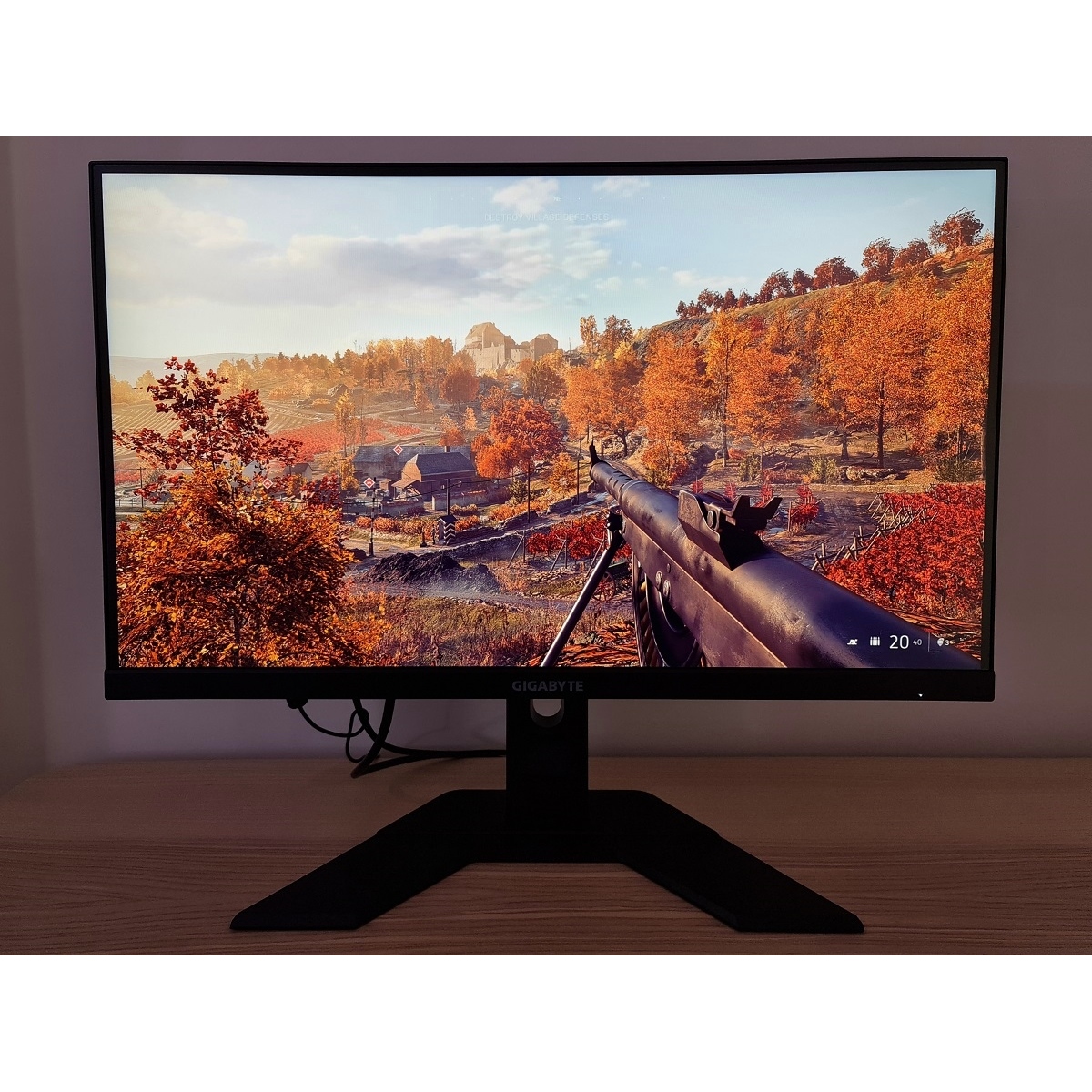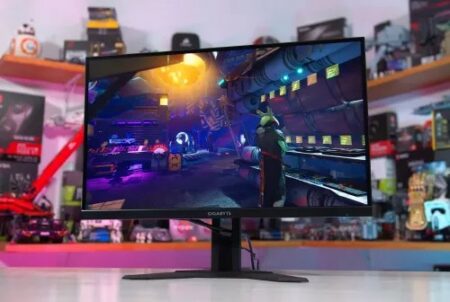CONS
- Low brightness and contrast ratio at default screen setting
- Stand is noisy
GIGABYTE M27Q X SPECS
| Panel Size (Corner-to-Corner) |
27 inches |
| Native Resolution |
2560 by 1440 |
| Aspect Ratio |
16:9 |
| Screen Technology |
Super Speed IPS |
| Rated Screen Luminance |
350 cd/m^2 |
| Rated Contrast Ratio |
1000:1 |
| Pixel Refresh Rate |
240 Hz |
| Adaptive Sync |
AMD FreeSync |
| Video Inputs |
HDMI, DisplayPort |
| USB Ports (Excluding Upstream) |
3 |
| VESA DisplayHDR Level |
DisplayHDR 400 |
| Dimensions (HWD) |
21 by 24.2 by 7.6 inches |
| Weight |
11.6 lbs |
| Height-Adjustable Stand? |
|
| Tilting Stand? |
|
| Swiveling Stand? |
|
| Landscape/Portrait Pivot |
|
Gigabyte has once again demonstrated its expertise as a reliable gaming monitor manufacturer by offering high-refresh-rate QHD monitors at affordable prices. The Gigabyte M27Q X is a prime example of this, providing a 1440p monitor that is packed with all the essential features one would expect from a gaming monitor, similar to its predecessor, the Gigabyte Aorus FI32Q. Despite not being a 4K panel, it excels in performance with an impressive 240Hz refresh rate and a range of unique features, such as an onboard KVM and numerous ports. While it falls short of perfection due to its lower brightness levels and average contrast ratio, it remains a top performer in its class.
Simplistic Design: The Elegance of Gaming Monitors.
The Gigabyte M27Q X offers a simplistic design that enhances the enjoyment of PC gaming. With its 27-inch screen and thin bezels on three sides, the monitor has a utilitarian look, complemented by the Gigabyte logo at the bottom. While some may find it familiar rather than visually striking, the display is connected to an adjustable stand that can be raised or lowered by about 5 inches, although it may produce some noise during movement. The V-shaped base provides sturdy support, although it lacks tilt or swivel functionality.
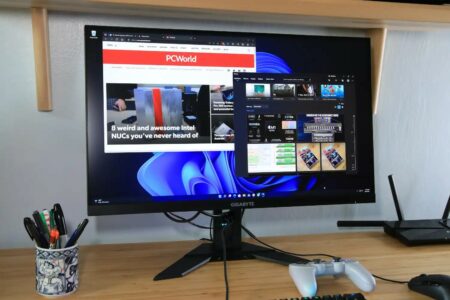
In terms of dimensions, the monitor has a size of 21 by 24.2 by 7.6 inches (HWD), which is similar to most other 27-inch monitors we have assessed, such as the MSI Optix MAG274QRF-QD. It weighs only 11.6 pounds, making it significantly lighter than the ViewSonic Elite XG270QG or Sony Inzone M9. This weight includes the stand. If you opt to remove the base and attach your monitor to a VESA mount or arm, the panel alone weighs just 7.7 pounds.
Upon examining the screen, the 27-inch IPS panel with “Super Speed” technology boasts a 1,000:1 contrast ratio and a VESA DisplayHDR 400 rating. These assertions will be tested in the near future. Fast IPS displays, marketed under different names, are said to offer response times four times quicker than traditional IPS displays due to a thinner liquid-crystal layer and increased driving voltage. The monitor is compatible with AMD FreeSync Premium and has a 1ms gray-to-gray (GTG) response time.
Upon inspection of the display, the 27-inch IPS panel featuring “Super Speed” technology guarantees a 1,000:1 contrast ratio and a VESA DisplayHDR 400 rating. These claims will be subject to testing at a later time. Fast IPS displays, marketed under various names, are said to provide response times four times faster than standard IPS displays, thanks to a thinner liquid-crystal layer and higher driving voltage. The monitor supports AMD FreeSync Premium and boasts a 1ms gray-to-gray (GTG) response time.
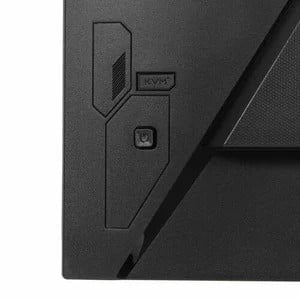
Positioned behind the monitor are two top-firing 2-watt speakers along with an analog stick designed for managing the onscreen display (OSD). Located above the stick is a button dedicated to the built-in keyboard/video/mouse (KVM) feature, enabling users to control multiple connected devices using a single mouse and keyboard. In order to utilize this function, simply connect your mouse and keyboard to the monitor and then link a compatible second PC or device using a USB-C cable. (Please note that the device must be capable of supporting DisplayPort over USB-C.) By pressing the KVM button, you can seamlessly switch between which computer is displayed on the screen and redirect the input devices accordingly.
The KVM may be the star of the show when it comes to unique features, but the I/O hub at the back has many noteworthy elements. All the necessary components are present: a DisplayPort jack, two HDMI 2.0 ports, an earphone jack, three USB 3.0 ports (two downstream, one upstream), and one USB-C port. Although there is no HDMI 2.1 port, the high-bit-rate 3 (HBR3) DisplayPort jack provides ample bandwidth to achieve the monitor’s maximum refresh rate, full color depth, and HDR simultaneously.
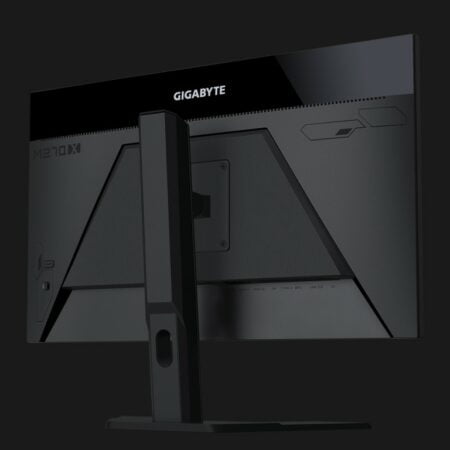
The most notable aspect of this situation is that the Gigabyte M27Q X is frequently available for significantly less than its retail price. There have been instances where it has been priced closer to, making it a budget-friendly option for a monitor, albeit just barely.
Evaluating the Gigabyte M27Q X: High Refresh Rates, Low Contrast Ratios.
The Gigabyte M27Q X is a strong competitor for gamers who value the visual output of their video card’s high frame rates. To comprehensively evaluate its performance against other monitors in the market, we will subject it to our standard gaming monitor tests using Datacolor’s SpyderX Elite tool and its corresponding software. Initially, we will assess the display in its default picture mode with an SDR signal. In this scenario, the Gigabyte M27Q X achieved a brightness of 210 nits and a black level of 0.93, resulting in a contrast ratio of 230:1, falling short of the advertised 1,000:1 ratio.
A monitor’s ability to produce deep blacks and bright whites is directly related to its contrast ratio. This is particularly important for enhancing picture quality, especially in dark scenes during gameplay. With the standard contrast ratio for IPS panels set at 1,000:1, a ratio of 230:1 can be quite challenging to accept.
Please be aware that we thoroughly test all our monitors right after unboxing them, using the default factory settings. However, this doesn’t imply that there are no methods to enhance the brightness level. One way to achieve this is by switching to the Movie mode on the monitor, which resulted in a notable improvement, measuring 430 nits of brightness in SDR mode. Additionally, it is crucial to take into account your viewing environment. A lower brightness reading might be advantageous for users situated in well-lit rooms, for instance.
Transitioning to HDR mode yielded improved outcomes, albeit only marginally. The luminance increased significantly from the standard SDR configuration, reaching 408 nits, meeting the specified DisplayHDR 400 requirements, resulting in a contrast ratio of 600:1.
Conversely, despite the low contrast, the color gamut performance was quite impressive on the Gigabyte M27Q X, achieving full coverage of 100% sRGB, 96% Adobe RGB, and 93% DCI-P3. These results surpass those of certain other QHD monitors we have assessed, such as the Razer Raptor 27.
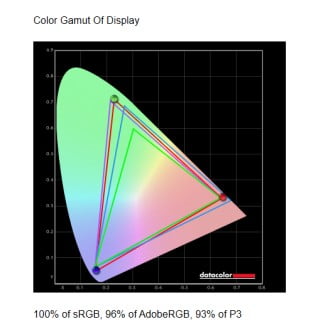
The color accuracy performed quite satisfactorily, achieving an average Delta E result of 1.66. A higher Delta E number indicates that common colors may deviate from their purest form, while a rating below 1 is considered ideal for accurate color representation. This aspect is particularly crucial for individuals using content creation tools, whereas it holds less significance for the average gamer. Those who prioritize color accuracy should consider exploring monitors designed specifically for photo editing purposes.
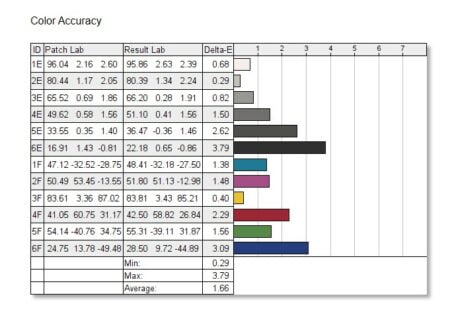
Media and Gaming Performance.
If you have previously read our monitor reviews, you will already be acquainted with the following information: Response time and input lag are two distinct concepts. Input lag refers to the duration it takes for the monitor to show a signal, whereas response time pertains to the time it takes for pixels to transition from one color to another.
The duration for a pixel to shift from one gray level to another is known as gray-to-gray or GTG. However, it is not a universally standardized measure as different vendors employ varying methods to measure these levels. This also holds true for other measurements such as black-white-black (BWB) and white-black-white (WBW).
Rather than evaluating response time, we assess input lag by utilizing the HDFury Diva Matrix. The Gigabyte M27Q X exhibited an impressive input lag of 1.6 milliseconds in this particular scenario. As you may have anticipated, a smaller value indicates superior performance in terms of input lag. Although certain monitors like the Corsair Xeneon 32QHD165 do measure below 1 millisecond, the disparity in this aspect would likely go unnoticed, except in rare instances during highly competitive esports matches.
The non-gaming viewing experience was exceptional, as there was no glare observed from any viewing angle. Additionally, the gaming performance was impressive, with no noticeable ghosting while playing Halo Infinite or Guardians of the Galaxy.
Strike a balance between Refresh Rate and Resolution.
The Gigabyte M27Q X is a monitor that hits the sweet spot, boasting a 240Hz refresh rate and QHD resolution. While its contrast and brightness fall short when compared to the Gigabyte Aorus FI32Q, it remains a solid choice for gamers seeking high frame rates without breaking the bank. This value-priced 1440p monitor deserves recognition for its performance.
The Gigabyte M27Q X is positioned as a sweet-spot monitor, offering a 240Hz refresh rate and QHD resolution. Although it falls behind in terms of contrast and brightness when compared to the Gigabyte Aorus FI32Q, it is still a great option for gamers aiming for high frame rates without spending a fortune. This affordable 1440p monitor is definitely deserving of praise.

